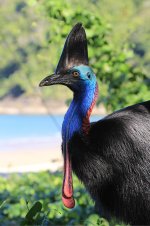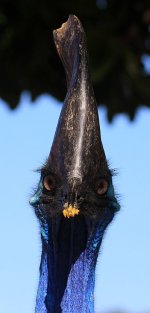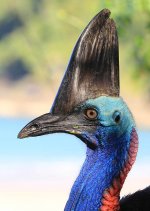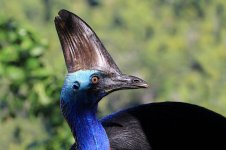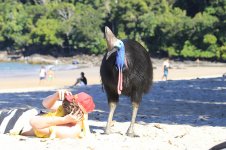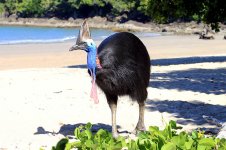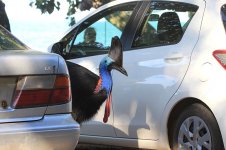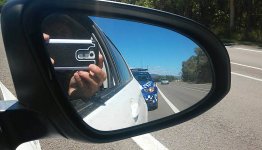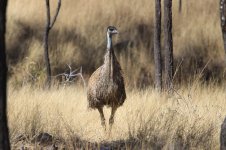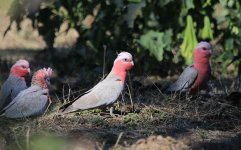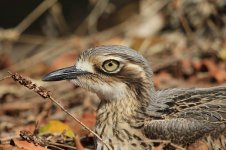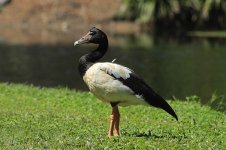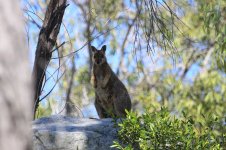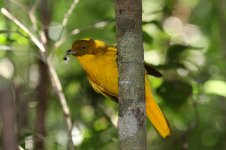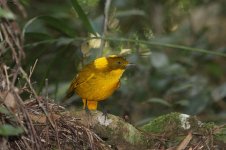
29 July. Mount Hypipamee & Etty Bay.
After an early morning around Yungaburra (Australian King Parrot the highlight), made a quick stop at Hasties Swamp again (Dusky Moorhen new), then a visit to Mount Hypipamee - mostly quiet, but an excellent fruiting fig with abundant Figbirds, Satin Bowerbirds and male Victoria's Riflebird, then cut down to the coast for the next leg of the trip.
Way back at the beginning of this trip, literally in the first moments of daylight on the first day, a certain person travelling with me had scored a Southern Cassowary from the car while I had trudged the road looking for them. Eight days on, despite numerous road signs warning of cassowaries, not a sniff of one I had. Departing Hypipamee, and yet another cassowary road sign, it was time for my secret weapon - Etty Bay.
Not really a 'secret' weapon though, as this beach is famous for its Southern Cassowaries that sometimes venture out onto the beach and hassle tourists, chasing them off or stealing food. And so it was, an hour or so later, we arrived at this picturesque bay, a small car park and campsite, forested slopes above and a sparkling blue sea beyond. Campsite area looked the optimal starting point for the cassowary I thought, remembering a video of the birds ambling around there, so off I went. My travel companion by contrast thought a nice bit of relaxing on the beach would be in order.
And no guesses for what happened next! Moments later, back came my travel companion with a grin and a repeat of the question from day one "So, have you seen your big bird?", followed by "It is on the beach!"
And indeed it was, an absolutely mega of a bird, an adult female sauntering along the sand, literally sending folk scurrying as it strolled past and took great interest in everything in its path. Females being the bigger and brighter of the sexes, this one was a giant - perhaps 1.6 metres tall, massive casque, colourful neck and face, impressive dangling wattles and, not what you would want lashing out at you, huge colossal feet! Occasional attacks by this species have resulted in serious injuries from the dagger-like claws, little wonder most folk wisely gave this bird due respect.
Rather amusing, one unfortunate guy sunbathing on the beach didn't see the bird approaching and opened his eyes only when the cassowary was already towering above him and jabbing with its beak! Beach guards quickly intervened and pushed the bird back with plastic chairs as shields. Overall however, it seemed fairly passive, so after a while watching in awe, I settled down to allow it wander close - a true privilege to be in the company of such a special bird.
Stayed with the bird a couple of hours and more, certainly one of the highlights of this trip to Australia. As sun began to descent, off the bird went, melting back into the tropical forests. Pottered around the general area to round the day off, Bush Stone-Curlews alongside a railway, Brown Goshawk overhead, a minimum of 50 White-breasted Wood Swallows gathering on electric wires.
After an early morning around Yungaburra (Australian King Parrot the highlight), made a quick stop at Hasties Swamp again (Dusky Moorhen new), then a visit to Mount Hypipamee - mostly quiet, but an excellent fruiting fig with abundant Figbirds, Satin Bowerbirds and male Victoria's Riflebird, then cut down to the coast for the next leg of the trip.
Way back at the beginning of this trip, literally in the first moments of daylight on the first day, a certain person travelling with me had scored a Southern Cassowary from the car while I had trudged the road looking for them. Eight days on, despite numerous road signs warning of cassowaries, not a sniff of one I had. Departing Hypipamee, and yet another cassowary road sign, it was time for my secret weapon - Etty Bay.
Not really a 'secret' weapon though, as this beach is famous for its Southern Cassowaries that sometimes venture out onto the beach and hassle tourists, chasing them off or stealing food. And so it was, an hour or so later, we arrived at this picturesque bay, a small car park and campsite, forested slopes above and a sparkling blue sea beyond. Campsite area looked the optimal starting point for the cassowary I thought, remembering a video of the birds ambling around there, so off I went. My travel companion by contrast thought a nice bit of relaxing on the beach would be in order.
And no guesses for what happened next! Moments later, back came my travel companion with a grin and a repeat of the question from day one "So, have you seen your big bird?", followed by "It is on the beach!"
And indeed it was, an absolutely mega of a bird, an adult female sauntering along the sand, literally sending folk scurrying as it strolled past and took great interest in everything in its path. Females being the bigger and brighter of the sexes, this one was a giant - perhaps 1.6 metres tall, massive casque, colourful neck and face, impressive dangling wattles and, not what you would want lashing out at you, huge colossal feet! Occasional attacks by this species have resulted in serious injuries from the dagger-like claws, little wonder most folk wisely gave this bird due respect.
Rather amusing, one unfortunate guy sunbathing on the beach didn't see the bird approaching and opened his eyes only when the cassowary was already towering above him and jabbing with its beak! Beach guards quickly intervened and pushed the bird back with plastic chairs as shields. Overall however, it seemed fairly passive, so after a while watching in awe, I settled down to allow it wander close - a true privilege to be in the company of such a special bird.
Stayed with the bird a couple of hours and more, certainly one of the highlights of this trip to Australia. As sun began to descent, off the bird went, melting back into the tropical forests. Pottered around the general area to round the day off, Bush Stone-Curlews alongside a railway, Brown Goshawk overhead, a minimum of 50 White-breasted Wood Swallows gathering on electric wires.
Last edited:




